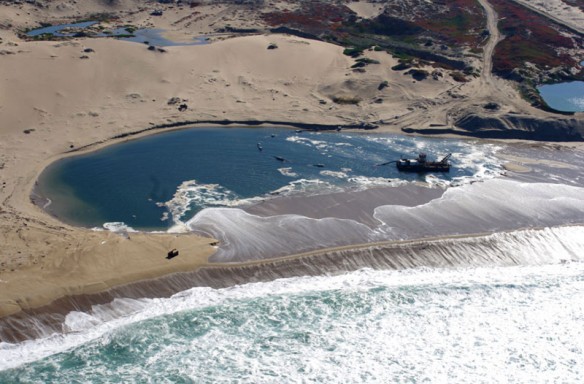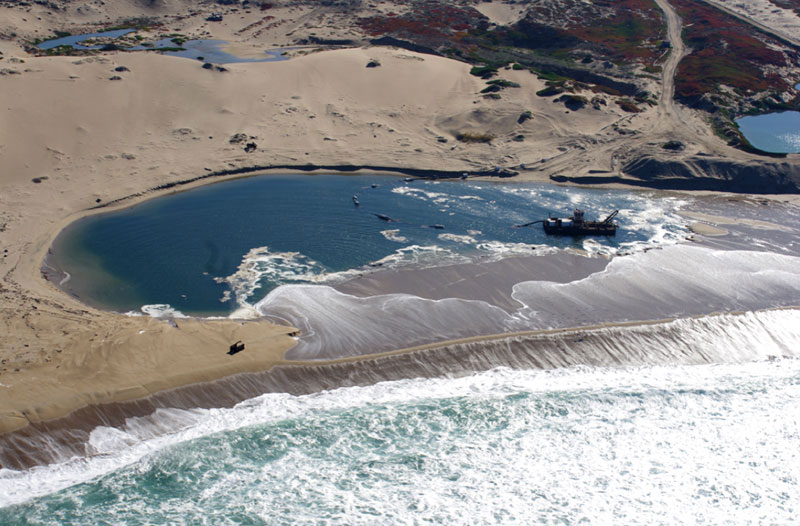
Monterey Bay. CEMEX extracts about 200,000 yds3 of sand from this back beach pond every year. Captions and Photograph courtesy of: © Gary Griggs
Excerpts;
The white pilothouse poking above the dunes on a remote beach in Monterey Bay is the first sign to visitors of an anachronistic industry that critics say is eating away California’s quintessential seacoast.
The Lapis Sand Plant, in operation since 1906, is the nation’s last coastal sand mine. It is believed to extract roughly 270,000 cubic yards of sand per year from a dredging pond on the beach, according to geologists and oceanographers who have studied the impacts.
The California Coastal Commission has threatened to close the plant, but the company refuses to relinquish its claim to the uniquely coarse amber-colored Monterey sand, which it calls “Lapis Lustre.”
But getting rid of the mine won’t be easy. Cemex is the world’s second largest building materials company, and any attempt to kick it out is likely to immerse the state in years of expensive litigation…
Read Full Article, San Francisco Chronicle (03-03-2017)
Castles made of sand, Santa Cruz Waves (06-23-2016)
How to Steal a Beach, Atlas Obscura (07-18-2016)
In Northern California’s Monterey Bay, a peculiar thing happens every time there’s a storm. The California Coastal Commission says that a mining operation has been illegally taking precious sand for years…
Cemex mine reflects human hunger for sand, California; Monterey County Now(01-14-2016)
The disappearance of the beach reflects an alarming reality: Southern Monterey Bay, Marina in particular, has the highest coastal erosion rate in the state of California. For more than 20 years, scientists have speculated about the sand mine’s contribution to that erosion rate, and a 2008 study concluded it was the primary cause. The Cemex mine in Marina is the only remaining coastal sand mine in the entire United States. Which leads to new questions…
Monterey Bay, California: Beach Sand Mining from a National Marine Sanctuary; By Gary Griggs (09-01-2014)
The 30-mile long, continuous sandy shoreline around Monterey Bay is the most visited stretch of shoreline on the central coast. Yet, it holds the dubious distinction of being the only active beach sand mining operation along the entire United States shoreline. To make matters even worse, it all takes place along the shoreline of a protected National Marine Sanctuary. Something is seriously wrong with this picture…
State sued over sand mining in San Francisco Bay, California; East Bay Times (01-31-2017)
Environmentalists are suing the state in an effort to reduce sand mining inside San Francisco Bay that they contend is shrinking a popular beach and habitat for an endangered bird…
The Conservation Crisis No One Is Talking About, By John R. Platt, TakePart (09-21-2016)
Beaches around the world are disappearing. No, the cause isn’t sea-level rise, at least not this time. It’s a little-known but enormous industry called sand mining, which every year sucks up billions of tons of sand from beaches, ocean floors, and rivers to make everything from concrete to microchips to toothpaste…
Sand, Rarer Than One Thinks: A UNEP report (GEA-March 2014)
Despite the colossal quantities of sand and gravel being used, our increasing dependence on them and the significant impact that their extraction has on the environment, this issue has been mostly ignored by policy makers and remains largely unknown by the general public.
In March 2014 The United Nations released its first Report about Sand Mining: “Sand, Rarer Than One Thinks.”
“Sand Wars” film documentary by Denis Delestrac – first broadcasted on the european Arte Channel, May 28th, 2013 in its french version: “Le Sable: enquête sur une disparition”, where it became the highest rated documentary for 2013 – expressly inspired the United Nations Environment Programme (UNEP) to publish this 2014-Global Environmental Alert.
Sand Wars, An Investigation Documentary, By Mutlti-Awards Winner Filmmaker Denis Delestrac (©-2013)









